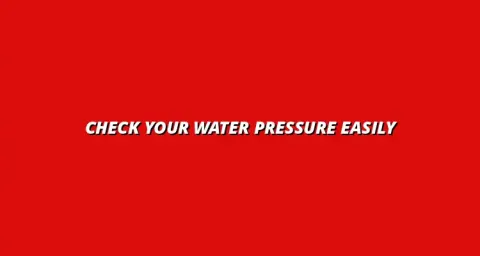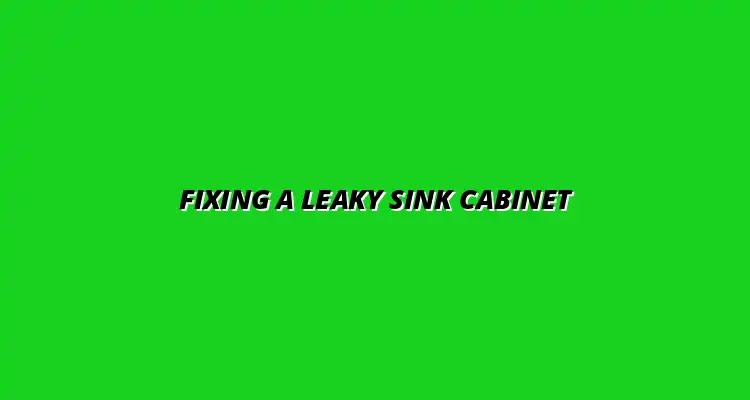
- Beginner Tips
- Feb 08
2025-02-21
When you discover a leak under your sink, it can be frustrating and concerning. Understanding the cause of the leak is crucial for effective repairs and to prevent further damage. Common sources of leaks include faulty faucets, drain issues, and supply line failures, which we'll explore in detail.
Identifying the source early can save you time, money, and damage to your cabinets. Each type of leak has its own signs and symptoms, so knowing what to look for makes a big difference. Let's dive into how to pinpoint these common issues!
Sinks can leak from various sources, and understanding these types can help in diagnosing the problem. The three main types include:
If you notice water pooling under your cabinet, it’s essential to check each of these components closely. Each leak type requires a unique approach for effective repair, so knowing which one you're dealing with is vital.
Detecting a leak quickly can help minimize damage to your home. Look for these common signs:
Pay attention to these signs, as they can often point you toward the source of the leak. Early detection is key to preventing more extensive damage! Learning to identify and fix leaky pipes can prevent larger problems down the road. See this guide for help: Identify and Fix Leaky Pipes.
As soon as you notice a leak, your first step should be to shut off the water supply. This prevents further water damage and gives you a chance to assess the situation without more leaks complicating things. Usually, the shut-off valves are located under the sink or near the water meter.
To find the valves, look for either round or rectangular knobs. If you’re unsure, you can always turn off the main water supply to your home as a precaution. Always remember: *safety first*!
Taking prompt action can save you from extensive repair costs. Water leaks can lead to issues like warped cabinets, damaged flooring, and even mold growth if not addressed quickly. Remember, the longer you wait, the more damage you could be facing! For simple plumbing repairs, this guide is a great starting point: Easy Plumbing Repairs for Homeowners.
So, after you shut off the water, it’s crucial to check the area carefully. By acting fast, you set yourself up for a smoother repair process.
Once the water is shut off, inspect the area under your sink for any visible damage. Look for signs like:
Evaluating these factors can give you a good idea of how long the leak may have been occurring and the extent of the damage. Taking note of these details will be helpful when discussing repairs.
It’s crucial to check for mold and mildew, especially in damp, dark areas. Mold can begin to grow within 24-48 hours of water exposure, making it an urgent concern. Look for:
Addressing mold quickly not only protects your cabinets but also your health. If you spot any mold, consider calling a professional for safe removal! Finding a reliable plumber can be easy with resources like Yelp.
When preparing to fix a sink leak, having the right tools is essential. Here are some tools you should gather:
These basic tools will help you tackle minor repairs effectively. If you find that the problem is more complex, you may need additional tools, but starting with these is a good plan! If you need a plumber in Birmingham, consider checking out Plumber in Billesley, Birmingham.
Along with tools, having the right materials on hand can make the process smoother. Here are some materials to consider:
Having these materials ready can help you not only fix the leak temporarily but also ensure a long-lasting solution! Always assess the damage to determine what you may need.
When you're diving into plumbing repairs, safety should be a top priority. Make sure to wear protective gear like:
This gear will keep you safe while you repair the leak. Always remember that safety is as important as fixing the problem!
Another critical step is to ensure electrical safety, especially if there are outlets near the sink. Here are some tips:
Being cautious around electricity and water is imperative to avoid dangerous situations. Always take the time to prioritize safety first! For dealing with a stuck bathroom drain plug, this guide is useful: Fixing a Stuck Bathroom Drain Plug.
Once you've identified the source of the leak, it's time to take action. Repairing a sink leak can save you from costly water damage and give you a sense of accomplishment. In this section, I will guide you through the process of fixing various types of leaks, from faucets to drains.
The first step in repairing a faucet leak is to identify the type of faucet you have. There are several common types, and knowing which one you’re dealing with will help direct your repair efforts. Here are the most common faucet types:
Once you know your faucet type, you can move forward with the appropriate repair techniques. Disassemble the faucet carefully, noting how the parts fit together. This will make reassembly easier later!
Each faucet type has unique repair techniques. Below are some quick tips for each type:
After making repairs, turn the water supply back on and check for leaks. If there are none, you successfully fixed your faucet leak!
If the leak is coming from the drain or the P-trap, it’s important to tackle it properly to prevent further issues. Start by checking all connections and seals for looseness. Often, simply tightening connections can solve the problem!
First, ensure you have the right tools on hand, such as a wrench and plumber’s tape. Then, follow these steps:
The P-trap can accumulate debris over time, leading to leaks. To clean it, follow these steps:
With these steps, you can address most common drain and trap issues effectively! For more extensive plumbing issues, such as a leaking water heater, consider consulting a professional plumber. See this guide for help: Fixing a Leaking Water Heater.
While many leaks can be fixed at home, some situations are more complex. Knowing when to call a professional plumber can save you time and money. Let’s discuss how to identify these complex plumbing issues.
If you encounter persistent leaks, strange noises, or water pooling that doesn’t seem related to visible sources, it’s best to consult a professional. Here are some signs that indicate the need for professional help:
Additional signs to watch for include:
If you notice any of these signs, reach out to a professional plumber for a thorough inspection.
Hiring a plumber may come with costs, but it's essential to understand what you're paying for. Professional plumbing services can range widely, depending on the complexity of the issue. Generally, you might expect the following:
Investing in professional services can save you from larger expenses in the long run!
Once you've repaired any present leaks, it’s wise to take steps to prevent future occurrences. A little maintenance goes a long way in ensuring your plumbing stays in good shape!
Here are some key maintenance tips:
Routine inspections are crucial to catching potential issues before they escalate. Make it a habit to check:
By staying proactive, you can keep your plumbing systems in top condition!
Let’s tackle some frequently asked questions regarding sink leaks. Understanding these topics can help enhance your plumbing knowledge!
Keeping an eye on your plumbing system can save you from unpleasant surprises. Setting up a regular inspection schedule is a great starting point!
Consider the following when creating your schedule:
Moisture detectors can also be a smart investment! They help by:
Using technology for early detection can make leak prevention a breeze!
Ignoring a sink leak can lead to serious repercussions. Let’s explore the potential long-term damage that can occur.
Water can cause extensive damage to wooden structures over time. Here are some risks associated with neglecting leaks:
Beyond structural damage, there are health risks to consider. Prolonged exposure to water can lead to:
Addressing leaks promptly protects both your home and your health!
In conclusion, managing sink leaks effectively requires knowledge, prompt action, and routine maintenance. By following the steps outlined above, you can become more confident in handling leaks and repairs!
Here’s a quick recap of essential steps:
With this knowledge, you’re ready to tackle any leak that comes your way!
For those who enjoy DIY projects, fixing sink leaks can be a rewarding endeavor. Remember, every small repair builds your skills and confidence!
Don’t wait to address leaks! Timely action can save you from major headaches and costs in the future. Keep that water flowing smoothly!
If you’re looking for additional help, there are many resources available. Here are a few:
Having a trusted plumber on speed dial can be beneficial. Don’t hesitate to reach out if you encounter complex issues!
